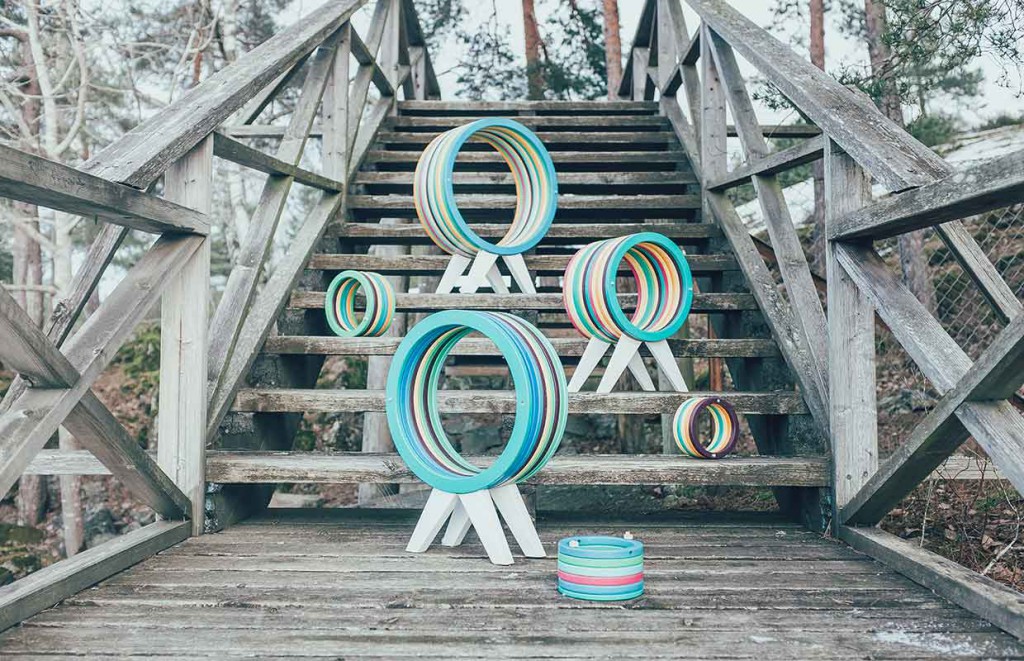Why do you design products for children?
I chose to design for children for my Master thesis because I saw that there was a need for products that grow with the children instead of being adapted for a specific age that causes the product to become superfluous as they grow older.

Wood Growth is a multi functional toy and furniture for kids designed for interaction and experience. The circles are easy for both adults and children to put together in different ways. The goal was to achieve a product with expanded lifetime that through use creates joy and history with the users. The main focus was inter-human interaction, learning and play. Especially interaction between generations since the youngest of the users, age 3 needs help. The separate circles can be played with by several kids at the same time, and creates interplay between both the people using the object and the object itself. To create an emotional connection with the product it’s essential to create memories with the product and the people we love. By parents or grandparents playing and building together with the children good memories will be created.

Wood Growth is designed for interaction, transformation and experience. The circles can be used singularly or joined, that gives the product countless areas of use. The product learns children construction, motoric skills, systematization and play. Wood Growth also encourage abstract play that doesn’t limit children fantasy, and the choice of a geometrical shape as a circle, gives no certain way of direction of how the product should be used. But instead encourages activity and motion since a circle is perceived as a shape that should be rolling. Since Wood Growth can be varied in so many different ways it will grow with the users, and makes it easier for each person needs and desires to be fulfilled. A relation will develop between the owner and the product that can lead to extended product life. The possibility to personalize the product and to create your own history with the product in interaction with elder generations and the interplay between the different user groups gives joy and memories.


The product is self – explanatory and is understood by the users intuitively. To make a product that’s not complicated avoids the risk of frustration and bad memories and enforces the feeling of mastering and pride. Wood Growth is visually appealing and urges touch with its bright colors and smooth surface that gives it a good tactile feeling. I’ve chosen not to use elementary colors since these often are used in children products, and I also wanted it to suit both girls and boys. Wood Growth is formed by several separate circles that grow with you, so that you can put the circles together in your suitable seating hight or work top. This also means that you can change the product into the function or desires your need, and the adaption to your needs creates a bigger sense of ownership. Each user needs and identity are considered and safeguarded by them shaping the product for their needs and the way they want to play with it. The singular circles are easy to keep clean and to clean, and they can easily be repaired or changed if they break.

Can you tell us about the manufacturing process?
I’ve been in contact with a local furniture manufacturer here in Norway, just outside Oslo where I’m based. I want Wood Growth to be locally produced which gives me the certainty that it will be produced by workers working under good conditions it also makes it easier to oversee.
Wood Growth is made by cnc-cutting the rings out of Birch plywood plates, this means that we use left overs from the wood industry to create a new product and a product that consists of natural materials. The production is set up in an efficient way so that we don’t use more material then we need, since the outer circles are the biggest ones that will be cut first and then we cut the smaller ones that are “set up” inside the bigger ones.
Good design for children – what does that mean for you?
Good design for kids to me means something that can grow with the child, that aids them and that is durable. As a prime example I can mention Tripp Trapp, the children chair by Peter Opsvik, produced by Stokke.
When it comes to toys I would say that the ball is one of the ultimate best designs, it fits all ages, trains your motoric skills, encourages interaction and activity and is a product that a lot of people can afford.
If you look into a crystal ball and predict your future as a designer: what children’s product would you like to design next?
First and foremost I would like to work more with products for children and further develop Wood Growth. And in the future I hope to be able to work on a project that is between digital learning, play and interaction, but that the interaction happens in the physical world and not with the Ipad. I think the clue is to bring real life interaction with people and nature with the digital platforms.

Get in touch with Hanah Berg via E-mail:
Photos Eric Haidara, Leyla Meyrick
